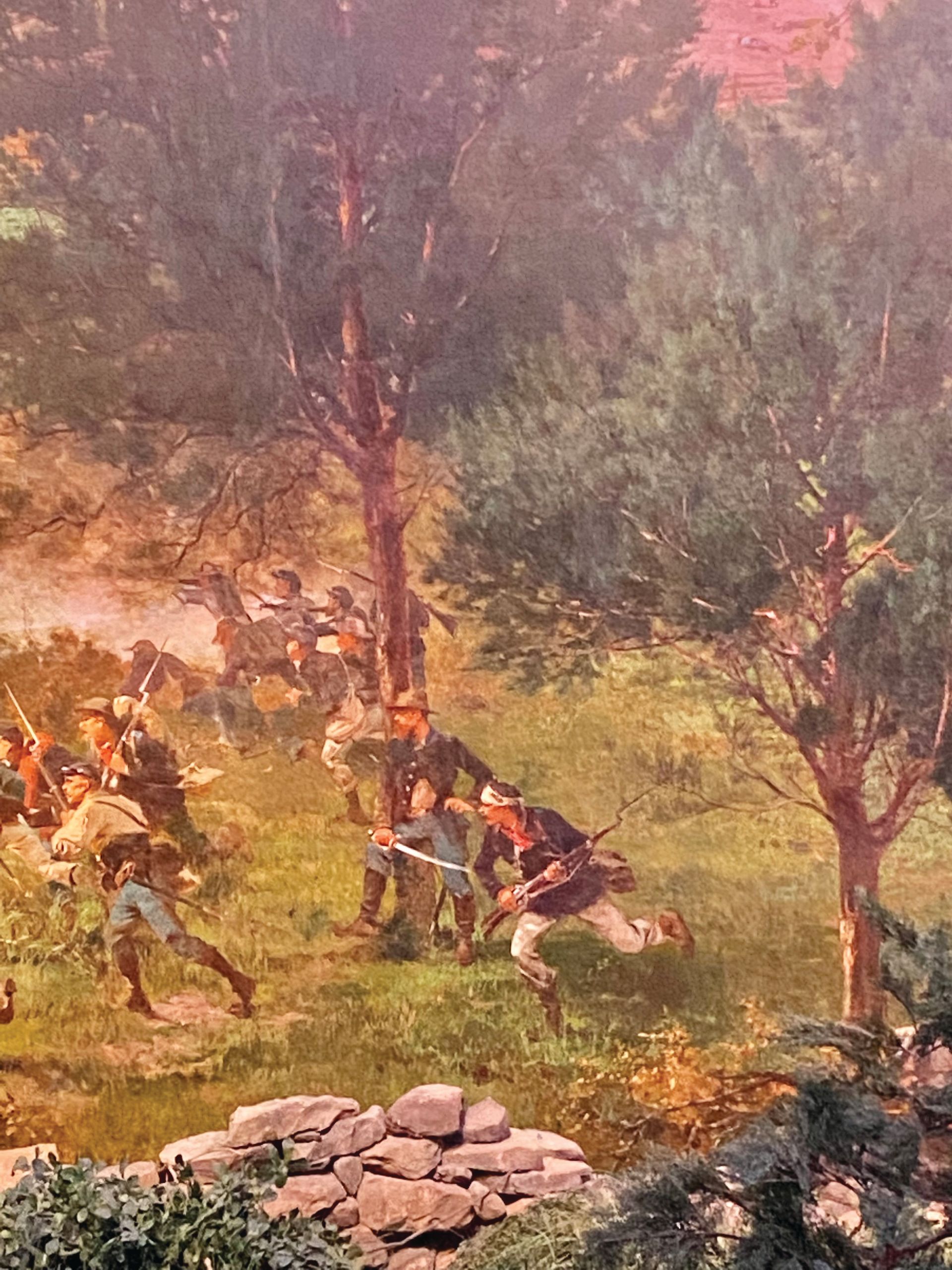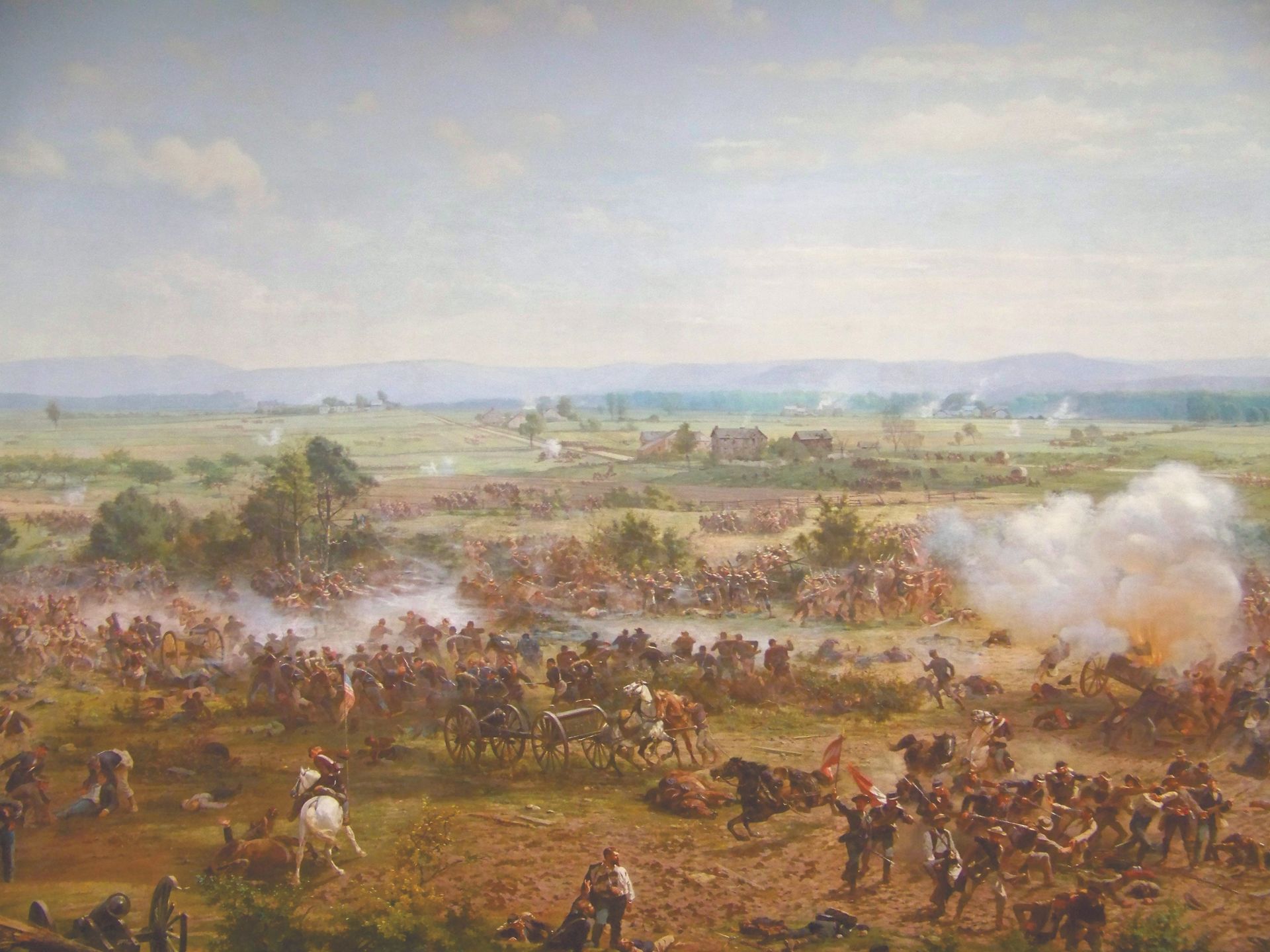The Greatest Artist of the 19th Century
by Diana Loski

Paul Philippoteaux, (standing) in the Gettysburg Cyclorama
(Author Photo)
Just over a century ago, in June 1923, an elderly man died in Paris. He was considered by many to be one of the greatest artists of all time, and celebrated around the world as the greatest of the 19th century. While many today couldn’t pronounce his name or remember any of his work, there is a colossal masterpiece that remains in Gettysburg. The Cyclorama painting, which is over five hundred feet in circumference and fifteen feet high, documents the climactic Pickett’s Charge. The creator of the magnificent artwork is Paul Philippoteaux, and his amazing painting is still appreciated by millions.1
In the early 1800s, the art form known as the panorama gained popularity for those who were interested in great historic events. It is described as “an immense circular canvas on which the artist paints a continuous scene and the spectator sees it from a central circular platform.” One of the artform's most renowned creators, Paul Philippoteaux, was born in Paris to another great artist, Henri Philippoteaux, and his wife Louise, in January 1846.2
A prodigy from a young age, Paul was tutored by his father and honed his talent after receiving an education at the Ecole des Beaux Arts
in Paris. He worked as an apprentice to his father and other great artists of the age, but showed an exceptional aptitude for historical detail.3
Paul traveled to many countries plying his artist trade, especially as the panoramas became a coveted fashion among the populations of the world. He lived for a time in Turkey, Russia, Israel, and Egypt, creating numerous paintings and cycloramas. In the early 1880s, he came to America and embarked on the creation of the first panoramic painting for the American Civil War.4
Mr. Philippoteaux interviewed numerous veterans of the Battle of Gettysburg, from major generals to enlisted men. Some who aided him with information about Pickett’s Charge included Major General Winfield S. Hancock, who features in the painting, and Generals Abner Doubleday, Alexander Webb, and O.O. Howard. Some of the human-interest stories portrayed in the panoramic painting will never be explained, but they add a dimension of action and tension to the finished work. Philippoteaux was especially grateful to General Hancock, who, he said, “gave me a number of interesting details.” The artist studied photos taken of the battlefield by Gettysburg photographers, particularly William Tipton.5
Philippoteaux utilized the talents of his father, Henri, and several carefully selected artists for the great project. The artist assigned his assistants to work on the background – the trees, the grass, the fences. Others worked on the combatants, their ordnance, and their horses. He studied not only the battle, but the uniforms, and everything a soldier carried into the fight. He said, “I had to study…everything I could come across to give me the absolute facts.”
He added that “the landscape must be absolutely truthful.” For that reason, he came to Gettysburg to see for himself.6
It is interesting to note when viewing the Gettysburg Cyclorama that a few items are indeed out of place. A haystack, visible in the background, is European in design and was not present at Gettysburg. Poppies, a European wildflower, dot the Pickett’s Charge field – but they never grew in Pennsylvania. These misinterpretations are few, however, as the actuality of the great battle looms over all. Soldiers in blue and gray grapple for the victory. Horses gallop, and the fear in their eyes is evident. Artillery belches fire. A hospital station stands nearby. George Meade’s headquarters, with the roof practically destroyed by artillery, looks as it must have appeared on July 3, 1863.
Philippoteaux explained his method for such an immense undertaking. “I must at the very beginning have a fair conception of what I want to do,
” he said. “Once my model is ready, the painting of the real panorama commences. The canvas is hung, prepared with a coat of white priming…1000 pounds of white paint are necessary. The [canvas] is held down at the bottom by weights…with different effects of temperation, this great canvas expands or contracts and if it were held fixed at one end it might tear or split.”7
For this immense task, the artist and his associates did the work in Paris. Usually, Philippoteaux worked about eight months on a panoramic painting. Because of the work needed to interview so many and become accustomed to an American war, the Gettysburg Cyclorama took nearly two years to complete.8
One of the most amazing aspects of the Gettysburg Cyclorama is the detail given to the woods, ridges, hills (including the Round Tops in the distance) and the sky. A humid July day is fully appreciated when viewing the sky of the painting. “The sky is one of the greatest troubles,” Philippoteaux explained. “It takes ten days to put the sky in – has to be painted as quickly as possible or it would be blotchy.”9
Philippoteaux first showed his masterpiece of Pickett’s Charge in Chicago in 1883, as investors from that city were the ones who solicited him for the work. He completed several copies that were shown in New York City, Boston, and Philadelphia, to great fanfare. Finally, the great Cyclorama found its permanent home in Gettysburg.
In addition to the epic painting, a diorama of shrubs, rocks, and military implements are scattered at the bottom of the piece to give the impression of the actual battlefield.
Paul Philippoteaux visited his sister in New Orleans shortly after completing his work for the Gettysburg Cyclorama. While staying there for many months, he courted a young woman named Marie Bechet. The couple married in New Orleans in 1885.10
Some of Philippoteaux’s other works include The Cyclorama of Jerusale , which depicts the crucifixion of Christ, The Taking of Plevna
– a battle between Russia and the Ottoman Empire in Turkey in 1877 – The Siege of Paris, and The Belgian Revolution. He painted many scenes from Egyptian life while living and working in that country, including his famous Women of the Nile. He created two panoramas that were displayed in London, including his most famous, The Derniere Sortie
(the last exit). He worked as an illustrator for many novelists, including Jules Verne and Alexandre Dumas. By the close of the nineteenth century, Paul Philippoteaux was considered “ among the foremost artists of Paris.” Critics hailed him as “ the greatest historical painter in the world.”11
When World War I broke out in 1914, the French artist believed that there would be a renewed interest in the waning popularity of panoramas. He and his wife returned to visit his sister in New Orleans, with the hope of finding work. Sadly, that was not the case, due to wide usage of film, and the aging artist returned to Paris.
Paul Philippoteaux died in Paris at age 77. He is buried in Montparnasse Cemetery in the French capital.12
While Paul Philippoteaux excelled in his chosen profession, he is best known today for the Gettysburg Cyclorama, which still is on display at the National Park Visitor Center. A close study of the painting reveals a bearded Union officer under a tree, watching the climactic fight unfold. It is a self-portrait of the artist.
While the panorama is no longer fashionable, there are still many that exist in Europe. Some were painted by other European artists, but a few remain that were created by Paul Philippoteaux and his father.
When veterans of the Battle of Gettysburg saw the Cyclorama, many were enthralled at the accuracy. Many wept at its realism. One hundred and sixty-one years after Pickett made his famous charge, we continue to find amazement in the epic moment created by Philippoteaux. The greatest artist of the 19th century traveled the world – and found his greatest creation at a place called Gettysburg.

A scene from the Gettysburg Cyclorama
(Author photo)
Sources: Ancestry.com: Paul Philippoteaux Family Tree. Ancestry.com: Marriage record of Paul Philippoteaux and Marie Bechet, 1885. Drake, Francis Samuel. Appleton’s Cyclopedia. Vol. VI, New York: private publisher, 1889. Letter, Mrs. Gordon to Mr. Simmons, April 25, 1962. The New York Times, Interview with the Artist, 1882. Philippoteaux File, Gettysburg National Military Park (hereafter GNMP). Paul Philippoteaux Biography Sketch, Philippoteaux File, GNMP.
End Notes:
1. Philippoteaux Family Tree, Ancestry.com. Philippoteaux Biography Sketch, Philippoteaux File, GNMP.
2. New York Times, interview 1882. Drake, p. 792.
3. Ibid.
4. Drake, p. 792.
5. New York Times, 1882. Philippoteaux Biography, GNMP.
6. Letter, Mrs. Gordon to Mr. Simmons, Apr. 25, 1962.
7. Ibid.
8. Philippoteaux Biography, GNMP.
9. New York Times, 1882.
10. Philippoteaux Marital Record, Ancestry.com.
11. Drake, p. 792.
12. Philippoteaux Biography Sketch, Philippoteaux File, GNMP.


